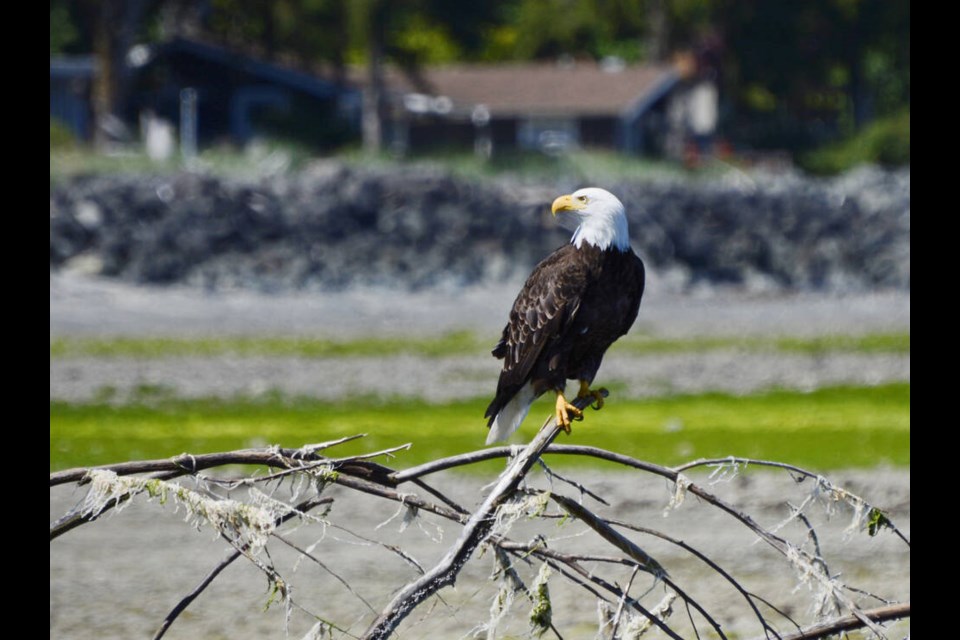There’s an albatross around the neck of the local eagle population.
The numbers of eggs being laid and chicks surviving once hatched have sharply dropped this year. Eagle trackers and researchers haven’t directly identified a cause, but are concerned about the dramatic decline in survival rate.
On the North Shore, 31 chicks hatched in 2021 with 24 of them surviving the process of leaving the nest, known as fledging, according to Sally McDermott of North Shore Eagle Network. This year, just 13 hatched and only five have fledged – nearly an 80-per-cent decrease in new eaglets.
A number of happenings over the past year could be at play. Last year’s heat dome could have caused stress or even killed some of the birds, and the devastating floods could have washed out some of the spawning salmon eagles rely on as a food source. Meanwhile, a wave of avian flu has spread among wild and domestic birds across the province.
“I would think this is a bit of a canary in a coal mine situation,” McDermott said. “This is happening in real time right now and is quite dramatic.”
That’s why she’s surprised the province hasn’t been responding to calls to test dead chicks.
“The provincial government doesn’t seem to have the time or the funding to analyze these chicks,” said McDermott, who’s been in contact with government officials via email. “That’s been very disappointing.”
In an email statement, the Ministry of Environment said it’s aware of the current situation.
“Biologists in the Ministry of Forests and Canadian Wildlife Service are currently conducting nest surveys of a variety of avian species and collecting carcasses when encountered,” a spokesperson said. “We do not have the results of this effort at this time.”
The ministry said it responds to and collects all bird carcasses possible for testing, including young eagles. “During the peak of avian influenza, we have prioritized testing of waterfowl, eagles and other raptors.”
The decline in new eagles extends beyond the North Shore. tracks over 400 pairs of nesting bald eagles in the Lower Fraser Valley.
Data from the organization show that in an active area in Delta, a network of 44 nests produces 44 young on average. This year, the nests produced just four young – a drop of nearly 91 per cent.
Another group of 22 nests in South Surrey typically sees around 24-26 young. This year, only five have survived, assuming all of them survive.
“We’re down to a very, very low percentage of success ratio, something we have never ever experienced before,” said David Hancock, an 85-year-old researcher that started studying eagles as a teenager.
After bounties on bald eagles were scrapped and use of nasty pesticide DDT was banned, the species has made a strong comeback over the last 50 years. But Hancock said 2022’s numbers are nowhere near enough to sustain the population.
He too is frustrated with the lack of testing of dead chicks.
With coronavirus surging, “Every lab in North America is again tied up with bloody COVID,” Hancock said, adding that priority is put on testing chickens, which will hit B.C.’s economy hard if they can’t be exported.
Earlier this year, the province had analyzed a few birds, detecting avian flu in some carcasses. “But more recently, there have been very few birds analyzed,” he said.
In some of the nests his foundation tracks, they’ve observed nearly full-grown dead chicks, something that’s hardly ever seen except in rare cases of sibling rivalry.
“And the parents know there’s something wrong because they’ve gone and built other nests nearby for next year already,” Hancock said.
Eagles facing broader threat to food sources, expert says
While the lifelong researcher concedes disease and other weakness could be at fault, there’s a broader, growing threat to these beloved raptors.
Over the past five to 10 years, Hancock has noticed food sources for avian predators are diminishing worldwide.
So-called scavenging predators hunt for part of the year. For bald eagles, that’s in the nesting season when feeding their young. But for the other half of the year, they scavenge for dead food. In both cases, fish is the natural source, either alive or dead after spawning.
While over-fishing has greatly depleted the fish stock eagles rely on, they’ve found another reliable food source: garbage.
There are over 100 garbage sites in the Lower Mainland. “This became a wonderful alternative food supply to salmon,” Hancock continued. “When the salmon carcasses ran out earlier and earlier every year, the eagles shifted to finding garbage.”
And what ecologically minded practice has become increasingly popular in recent years? Composting.
“We’re taking all the compostables, the protein and the vegetable matter, and we’re putting it into a green box,” Hancock said. “And the result is there simply isn’t the same amount of food left in this area.”
That dearth affects both migrating birds and the nesting eagle populations. And he believes we’re beginning to see the consequences.
On the North Shore, there aren’t any major waste sites to feed on, but Hancock speculates that these eagles are facing increased competition from hungry birds along the shorelines.
Fortunately, eagle chicks have been more successful this year in other areas of the province, such as Vancouver Island and a number of the Gulf Islands.
But other countries like Japan have grappled with diminishing eagle populations due to food scarcity, and have begun measures to bring them back.
We’re not looking at a simple story with a simple fix, Hancock said.
“We’ve taken away their goddamn salmon, and we’ve substituted garbage. We’ve now taken away the garbage. This is a huge impact that most people have not yet tied together.”



